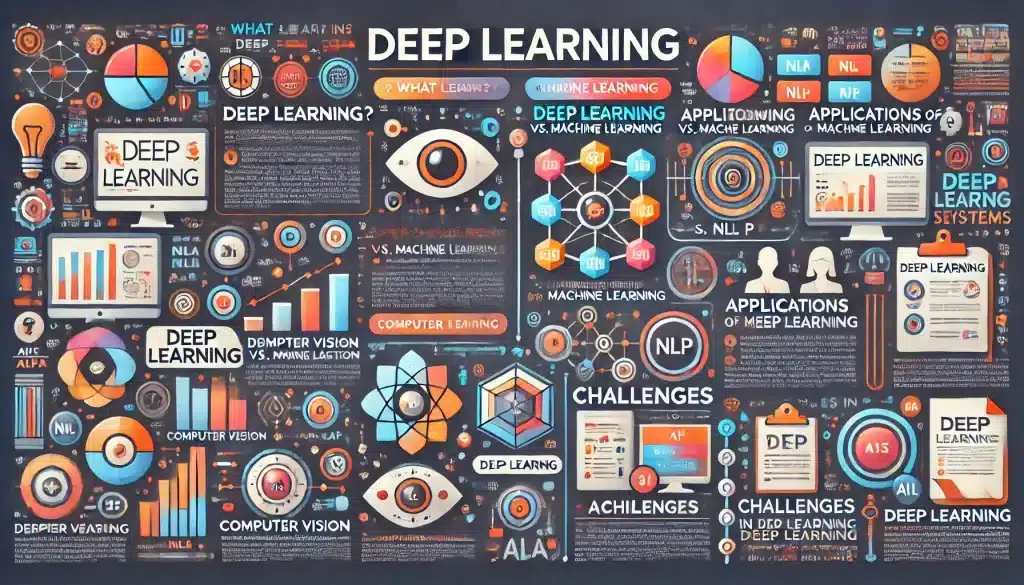Deep learning is a revolutionary technology that has gained significant prominence in the field of artificial intelligence (AI). It differs from traditional machine learning in its complex neural network architecture and the ability to learn from large amounts of data. This article will delve into the fundamentals of understanding deep learning and its diverse applications across various industries.

What is the Difference Between Deep Learning and Machine Learning?
Machine learning and deep learning are both subsets of AI, but they vary in terms of complexity and learning algorithms. Machine learning focuses on algorithms that can learn from and make predictions on data, while deep learning involves more intricate neural networks capable of learning from large amounts of data with multiple layers of abstraction.
Exploring the Basics of Machine Learning and Deep Learning
Machine learning encompasses a wide range of learning techniques, including supervised, unsupervised, and reinforcement learning. On the other hand, deep learning is characterized by the use of deep neural networks, such as convolutional neural networks (CNNs) and recurrent neural networks (RNNs), to process and analyze complex data.
Key Variances in Algorithms Between Machine Learning and Deep Learning
The primary difference lies in the learning algorithms used. Machine learning algorithms rely on feature engineering and manual extraction of relevant features, whereas deep learning algorithms automatically learn hierarchical representations of data directly from raw input.
Understanding the Neural Networks in Deep Learning
Neural networks are at the core of deep learning models. These networks consist of interconnected nodes that are organized into layers, including an input layer, hidden layers, and an output layer. Each layer processes information before passing it on to the next layer for further abstraction.
How Does Deep Learning Work?
Understanding deep learning operates by utilizing deep neural networks to process data and extract meaningful insights. These networks consist of multiple layers of interconnected nodes that process data through complex mathematical operations known as backpropagation.
Overview of Deep Learning Methods
Deep learning methods involve training deep neural networks on massive datasets to learn intricate patterns and relationships within the data. This process enables the network to make accurate predictions and classifications on new, unseen data.
Deep Learning Network Architecture
The architecture of deep learning networks plays a crucial role in the performance of the model. Convolutional neural networks (CNNs) are commonly used in computer vision tasks, while recurrent neural networks (RNNs) excel in processing sequential data in applications like natural language processing.
The Significance of Deep Learning in AI
Deep learning has significantly contributed to the advancement of AI by enabling machines to perform tasks that require human-like intelligence. Through deep learning algorithms, AI systems can recognize patterns, understand languages, and make decisions based on vast amounts of data.
What Are the Applications of Deep Learning Technology?
The applications of deep learning technology are widespread across various domains, from computer vision to natural language processing and artificial intelligence systems. Let’s explore some of the key applications in detail.
Deep Learning in Computer Vision
Computer vision leverages deep learning algorithms to analyze and interpret visual data, such as images and videos. Applications include facial recognition, object detection, and autonomous vehicle navigation.
Utilizing Deep Learning for Natural Language Processing
Natural language processing (NLP) involves the interaction between computers and human language. Deep learning models, such as recurrent neural networks (RNNs) and transformer models, have revolutionized language translation, sentiment analysis, and chatbot development.
Deep Learning in Artificial Intelligence Systems
It serves as the backbone of many artificial intelligence systems, enabling machines to learn, adapt, and make decisions autonomously. Applications range from healthcare diagnostics to financial forecasting and personalized recommendations.
What are the Challenges of Implementing Deep Learning?
Implementing deep learning poses several challenges, particularly in dealing with large amounts of data, optimizing network architectures, and training deep neural networks effectively. Overcoming these challenges is crucial for the successful deployment of deep learning models.
- Dealing with Large Amounts of Data in Deep Learning
Deep learning models require massive datasets for training, which can be cumbersome to collect, clean, and process. Techniques like data augmentation and transfer learning help mitigate the impact of limited data availability.
- Network Architectures for Addressing Deep Learning Challenges
Designing efficient network architectures is essential for optimizing the performance of deep learning models. Researchers continuously explore new architectures, such as attention mechanisms and capsule networks, to enhance model efficiency and accuracy.
- Training and Optimizing Deep Neural Networks
Training deep neural networks involves fine-tuning various parameters, such as learning rates and activation functions, to achieve optimal performance. Techniques like batch normalization and dropout regularization aid in preventing overfitting and improving generalization.
Why is Deep Learning Important in the Field of Artificial Intelligence?
Deep learning plays a pivotal role in advancing the capabilities of artificial intelligence systems by mimicking the learning processes of the human brain. Its ability to process complex data and extract meaningful insights has revolutionized various industries and applications.
The Concept of Deep Learning as a Subset of Machine Learning
Although deep learning is a subset of machine learning, it surpasses traditional machine learning techniques in handling intricate data representations and learning hierarchies of features. This makes it more suitable for tasks requiring high-level pattern recognition.
Comparing Deep Learning with the Human Brain’s Learning Process
The architecture of deep learning models, inspired by neural networks in the brain, enables machines to learn from examples and adapt to changing environments. This parallel to the human brain’s learning process enhances AI systems’ capacity to handle diverse tasks efficiently.
Implications of Deep Learning in AI Advancements
Deep learning has fuelled significant advancements in AI across industries, ranging from healthcare and finance to autonomous driving and predictive analytics. Its applications continue to broaden, paving the way for more sophisticated AI systems and generative AI capabilities.
Understanding Deep Learning AI: An Informative Guide
In the ever-evolving realm of artificial intelligence (AI), deep learning stands out as a particularly exciting and rapidly developing field. Drawing inspiration from the structure and function of the human brain, deep learning empowers machines to process large amounts of data, recognize patterns, and make decisions with unprecedented accuracy. This guide dives deep into the fundamentals of deep learning, its significance, the common methods and algorithms it employs, and how you can start your journey in this fascinating area.
What is Deep Learning and How Does It Work?
Definition of Deep Learning
Deep learning is a subset of machine learning, which itself is a branch of AI. At its core, deep learning involves training artificial neural networks to learn and make decisions by processing large amounts of data. Think of it as a way of teaching machines to learn from experience, much like the human brain does. Unlike traditional machine learning, which often requires manual feature extraction, deep learning automates this process by leveraging multiple layers of neurons in the network architecture.
How Deep Learning Differs from Traditional Machine Learning
Traditional machine-learning models require feature extraction by humans. Experts determine which features are most important for the task at hand, and then the machine learning algorithms use those features to make predictions. Deep learning flips the script by automating this process. With deep learning, the learning algorithms can directly work on raw data and automatically discover representations needed for classification or detection. This self-learning ability is what sets deep learning apart from traditional machine learning techniques.
The Role of Neural Networks in Deep Learning
Neural networks are the backbone of deep learning. An artificial neural network mimics the human brain’s neurons, connected via synapses. In a deep neural network, there are multiple hidden layers between the input layer and the output layer. Each neuron processes input data and passes its output to the next layer. The ‘deep’ in deep learning refers to these multiple layers, which allow for more complex data representations and improved accuracy in tasks like computer vision and natural language processing.
Why is Deep Learning Important in AI?
Impact on Various Industries
Deep learning has revolutionized numerous sectors, from healthcare to finance and beyond. In healthcare, deep learning models are used for diagnostic tasks such as analyzing medical images and predicting disease outbreaks. Financial institutions leverage deep learning algorithms for fraud detection and risk management. Even in entertainment, AI applications like content recommendation systems owe their effectiveness to deep learning technology.
Advantages of Deep Learning over Traditional Machine Learning
One of the biggest advantages of deep learning over traditional machine learning is its ability to handle large amounts of unstructured data, such as images, audio, and text. Unlike traditional machine learning methods, which require predefined features, deep learning models can automatically discover the most relevant features by processing data through multiple layers of abstraction. This allows for improved accuracy and the ability to solve more complex problems.
- Machine Learning: Depends on the manual extraction of features.
- Deep Learning: Uses hierarchical data representations to automate feature discovery.
Significance in Advancing AI Technologies
Deep learning is fundamental to advancements in AI, from powering intelligent assistants like Siri and Alexa to enabling breakthroughs in autonomous driving. Generative AI, which involves creating new data instances, relies heavily on deep learning techniques. Moreover, deep learning serves as the foundation for large language models capable of understanding and generating human-like text. The advancements in neural network architectures are making these transformative AI applications a reality.
What are the Common Deep Learning Methods and Algorithms?
Types of Deep Learning Networks
There are several types of deep neural networks, each designed for specific tasks. Convolutional neural networks (CNNs) are particularly effective for image recognition and computer vision tasks. Recurrent neural networks (RNNs) are designed for sequence data and time-series analysis, making them ideal for natural language processing and machine translation. Reinforcement learning, which focuses on training models through rewards and punishments, is another critical deep learning network used in creating game-playing AI and autonomous robots.
Popular Deep Learning Algorithms
A few deep learning algorithms have become particularly popular due to their effectiveness and versatility. These include the Backpropagation algorithm, which efficiently calculates the gradient of the loss function, allowing the network to learn. The Adam optimizer is another favorite for training deep neural networks because it combines the advantages of two other popular algorithms: AdaGrad and RMSProp. Transfer learning is also commonly used, which involves pre-training a model on a large dataset and fine-tuning it for a specific task, saving both time and computational resources.
Applications of Different Deep Learning Methods
Deep learning methods have diverse applications across various fields. Convolutional neural networks are widely used in computer vision tasks like facial recognition, object detection, and medical image analysis. Recurrent neural networks along with Long Short-Term Memory (LSTM) and Gated Recurrent Units (GRUs) are essential for natural language processing tasks such as sentiment analysis, language translation, and speech recognition. Deep reinforcement learning has found applications in autonomous driving, robotic control, and game-playing AI, showcasing the versatility and power of deep learning techniques.
Challenges and Limitations of Deep Learning
Data Requirements and Processing
One of the main challenges in deep learning is the need for vast amounts of data. Deep learning models require a large amount of data for training to achieve high accuracy. However, collecting and processing this data can be resource-intensive. Data preprocessing, involving cleaning and organizing the data, is a crucial step that requires significant effort and computational resources.
Complexity and Computational Costs
Deep learning models are complex and demand substantial computational power. Training deep neural networks can be incredibly time-consuming, requiring specialized hardware like GPUs or TPUs to expedite the learning process. The computational costs involved can be a barrier for smaller organizations or individual researchers without access to high-performance computing resources.
Ethical and Societal Considerations
With great power comes great responsibility. The use of deep learning technologies raises ethical and societal concerns, such as bias in AI algorithms, privacy issues, and the potential for misuse. Ensuring that deep learning models are trained on unbiased data and used in ethically responsible ways is paramount. Additionally, there are societal impacts to consider, including the potential displacement of jobs due to automation and the need for regulatory frameworks to govern AI applications.
How to Get Started with Deep Learning?
Recommended AI Courses and Learning Resources
Getting started with deep learning requires a solid foundation in both theoretical knowledge and practical skills. There are numerous online courses and resources available for beginners and advanced learners alike. Platforms like Coursera, edX, and Udacity offer comprehensive deep-learning specializations that cover everything from basic principles to advanced techniques. Books like “Deep-Learning” by Ian Goodfellow and “Hands-On Machine Learning with Scikit-Learn, Keras, and TensorFlow” by Aurélien Géron are invaluable resources to deepen your understanding.
Building and Training Your First Deep Learning Model
Once you’ve grasped the basics, the next step is to get hands-on experience by building and training your first deep-learning model. Start with simple projects, such as classifying handwritten digits using the MNIST dataset. Many online platforms provide accessible environments for training deep neural networks, such as Google Colab, which offers free GPU access and pre-installed libraries like TensorFlow and PyTorch. Experiment with different network architectures, adjust the learning rate and explore the impact of various hyperparameters on your model’s performance.
Tools and Frameworks for Deep Learning Development
Once you’ve grasped the basics, the next step is to get hands-on experience by building and training your first deep-learning model. Start with simple projects, such as classifying handwritten digits using the MNIST dataset. Many online platforms provide accessible environments for training deep neural networks, such as Google Colab, which offers free GPU access and pre-installed libraries like TensorFlow and PyTorch. Experiment with different network architectures, adjust the learning rate, and explore the impact of various hyperparameters on your model’s performance.
Conclusion
Deep learning is revolutionizing industries in processing vast data and yielding human-like intelligence. This ability faces challenges such as high data needs and great computational demands, but growth persists in this sector because of advancements in tools and techniques. The ideal time is now to venture into this new, exciting field shaping the future of AI.
Frequently asked questions
Q: What exactly is deep learning?
A: Deep learning is a branch of machine learning that uses algorithms called neural networks to analyze data and learn patterns. It’s like teaching computers to think and learn similar to humans.
Q: How does deep learning differ from traditional machine learning?
A: The main difference in deep learning vs. traditional machine learning lies in how data is processed. Traditional machine learning often requires manual feature extraction, while deep learning forms its features through multi-layered networks, making it more efficient for complex tasks.
Q: Why is understanding deep learning important in today’s technology?
A: Deep learning is important because it drives many modern applications like image recognition, natural language processing, and even self-driving cars. Its ability to automatically learn from vast amounts of data makes it essential for technological innovation.
Q: What are some examples of deep learning applications?
A: Some common deep learning applications include voice assistants like Siri and Alexa, recommendation systems on Netflix and YouTube, and medical image analysis tools used in healthcare.
Q: What challenges do deep learning systems face?
A: Deep learning systems often face challenges such as the need for large datasets, high computational power, and difficulty in interpreting complex models. These hurdles make it essential to have a robust deep-learning framework in place.
Q: Can you explain the types of neural networks used in deep learning?
A: Sure! Common types of neural networks used in deep learning include Convolutional Neural Networks (CNNs) for image data, Recurrent Neural Networks (RNNs) for sequential data like text, and Generative Adversarial Networks (GANs) for creating new data samples.
Q: What is the deep learning process like?
A: The deep learning process involves feeding data into a deep network, training the model using algorithms, and validating the model to ensure it accurately makes predictions or decisions.
Q: How is supervised learning different from unsupervised learning in deep learning?
A: Supervised learning uses labeled data to teach the system, meaning the input and output pairs are known. Unsupervised learning, on the other hand, works with unlabeled data, making the system find hidden structures and patterns on its own.
Q: What is meant by understanding deep learning architecture?
A: Deep learning architecture refers to the specific design of neural networks and how they’re structured. This can include the number of layers, types of layers, and how they interconnect, which affects how the network learns and processes information.
Q: What advantages does deep learning have over machine learning?
A: Deep learning often performs better with large datasets and complex functions compared to traditional machine learning techniques. It can automatically extract features from raw data and excel in tasks like image and speech recognition where traditional methods might struggle.



